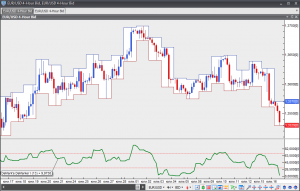DeMarks DeMarker I
This lesson will cover the following
- Explanation and calculation
- How to interpret this indicator
- Trading signals, generated by the indicator
Developed by Thomas DeMark, the DeMarker I indicator attempts to measure demand of a trading instrument by comparing the high and low prices of the current bar with the high and low prices of the prior bar. This way it helps to identify potential price peaks and bottoms. The DeMarker I is meant to overcome the common shortcomings of traditional indicators, that identify overbought and oversold conditions.
The DeMarker I is comprised by two indicators – DeMax and DeMin. DeMax compares the high price of the current bar with the high price of the prior bar. DeMin compares the low price of the current bar with the low price of the prior bar.
The DeMarker indicator fluctuates between -100 and +100 and can generate various signals:
First, it is used in order to identify overbought and oversold conditions. In this case it functions in a similar way to the Relative Strength Index (RSI) and uses the same extreme levels (30 for oversold and 70 for overbought).
Second, looking for bullish or bearish divergences between the DeMarker and the price of the trading instrument, just like the case with traditional overbought/oversold indicators.
Third, drawing trendlines between peaks and bottoms, which are formed by the DeMarker. Trading signals, in this case, are generated as the indicator breaches above or below the trendlines.
